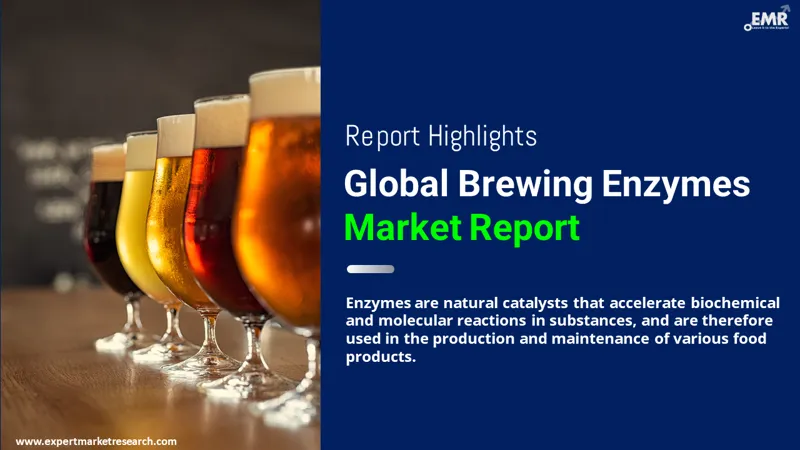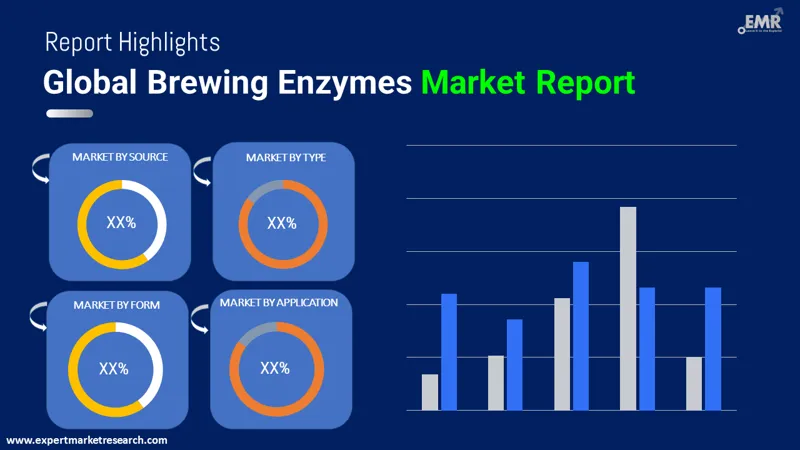
Consumer Insights
Uncover trends and behaviors shaping consumer choices today
Procurement Insights
Optimize your sourcing strategy with key market data
Industry Stats
Stay ahead with the latest trends and market analysis.
The global brewing enzymes market is expected to grow at a CAGR of 6.00% over the forecast period of 2026-2035 to attain a value of USD 760.33 Million by 2035. The market is being driven by the rise in disposable incomes among consumers and the increasing consumption of beers globally.
Base Year
Historical Period
Forecast Period
Compound Annual Growth Rate
6%
2026-2035
*this image is indicative*
The amylase segment, among other types, accounted for one of the largest shares in the industry owing to its cost-effectiveness, and reduced time and ease to optimise the process involving amylase. As the access to malt in regions like Africa and the Asia Pacific is lower, the consumption of amylase has increased significantly in such regions, which is driving the growth of this segment, and ultimately aiding the overall market growth. Further, microorganisms, among other sources of brewing enzymes, accounts for a significant share in the global industry as they can produce a significant amount of the desired enzyme and are easy to handle.

Read more about this report - REQUEST FREE SAMPLE COPY IN PDF
Region-wise, the Asia Pacific is expected to account for a significant share in the global market owing to the presence of a large population and increased production and consumption of brewing enzymes in the region. Within the Asia Pacific, countries like Vietnam, China, Australia, and New Zealand serve as the significant markets for the product. Further, in Western European countries, the growing preference of craft breweries, along with the rising health awareness regarding beer consumption, has fuelled the growth of the brewing enzymes industry in the region.

Read more about this report - REQUEST FREE SAMPLE COPY IN PDF
Enzymes are biological catalysts that hasten the biochemical and molecular reaction in substances, and thus, are utilised for the maintenance and production of various food products. Enzymes such as amylases, proteases, and others are becoming increasingly important in the brewing industry in order to accelerate the production of beers without affecting their original structure.
The various sources of brewing enzymes are
The different types of brewing enzymes available in the market include
The brewing enzymes are available in different forms, which are
It has applications in industries such as
Based on region, the market can be divided into:
The global market for brewing enzymes is being driven by its growing demand in the brewing industry and rise in the consumption of beer with rising global population. These enzymes speed up the chemical reaction involved in the brewing process, further allowing to achieve improved product quality without a change in its structure. Thus, commercial enzymes are used by manufacturers in order to make the brewing process faster, easier, and more consistent. Also, manufacturers are increasingly focusing on commercial enzymes to enhance the productivity, and for the use of raw material alternatives to malt in the brewing process. These enzymes can help enhance the beer quality with unmalted barley.
Among its various applications, the demand for brewing enzymes in beer production is anticipated to increase significantly in the forecast period owing to the increased popularity of beer, especially among young consumers. Further, rapid technological innovations and the increased demand for craft beer, coupled with a number of new microbreweries facilities, are expected to aid the industry in the future.
In the European region, the growing production of wine, flavoured beers, and gluten-free beers, coupled with the rising demand for premium and luxury products, is driving the demand for brewing enzymes. While in developing regions such as the Asia Pacific, the factors like rising disposable incomes, acceptance of new technology, a shift in cultural patterns, and rising demand for quality beer and wine products, are expected to have a positive impact on the growth of the brewing enzymes industry in the region, thus, aiding the overall market growth.
The report gives a detailed analysis of the following key players in the global brewing enzymes market, covering their competitive landscape, capacity, and latest developments like mergers, acquisitions, and investments, expansions of capacity, and plant turnarounds:
The comprehensive EMR report provides an in-depth assessment of the market based on the Porter's five forces model along with giving a SWOT analysis.




*While we strive to always give you current and accurate information, the numbers depicted on the website are indicative and may differ from the actual numbers in the main report. At Expert Market Research, we aim to bring you the latest insights and trends in the market. Using our analyses and forecasts, stakeholders can understand the market dynamics, navigate challenges, and capitalize on opportunities to make data-driven strategic decisions.*
Get in touch with us for a customized solution tailored to your unique requirements and save upto 35%!
The market is projected to grow at a CAGR of 6.00% between 2026 and 2035.
The major drivers of the market include rising global population, rapid technological innovations, increased demand for craft beer, development of new microbreweries facilities, growing demand for premium and luxury products, a shift in cultural patterns, and increasing demand for quality beer and wine products.
The increasing consumption of beers globally and growing popularity of breweries are the key trends propelling the market's growth.
The major regions in the market are North America, Latin America, the Middle East and Africa, Europe, and the Asia Pacific.
The various sources of brewing enzymes are plants and microbial, among others.
Amylase, beta-glucanase, protease, peptidase, and xylanase, among others are the dominant types of brewing enzyme in the market.
The different forms of brewing enzymes include dry and liquid.
The major applications include wine and beer, among others.
The key players in the global brewing enzymes market are DuPont de Nemours, Inc., Novozymes A/S, Koninklijke DSM N.V., Kerry Inc., and Amano Enzyme Inc, among others.
Explore our key highlights of the report and gain a concise overview of key findings, trends, and actionable insights that will empower your strategic decisions.
| REPORT FEATURES | DETAILS |
| Base Year | 2025 |
| Historical Period | 2019-2025 |
| Forecast Period | 2026-2035 |
| Scope of the Report |
Historical and Forecast Trends, Industry Drivers and Constraints, Historical and Forecast Market Analysis by Segment:
|
| Breakup by Source |
|
| Breakup by Type |
|
| Breakup by Form |
|
| Breakup by Application |
|
| Breakup by Region |
|
| Market Dynamics |
|
| Competitive Landscape |
|
| Companies Covered |
|
| Report Price and Purchase Option | Explore our purchase options that are best suited to your resources and industry needs. |
| Delivery Format | Delivered as an attached PDF and Excel through email, with an option of receiving an editable PPT, according to the purchase option. |
Datasheet
One User
USD 2,499
USD 2,249
tax inclusive*
Single User License
One User
USD 3,999
USD 3,599
tax inclusive*
Five User License
Five User
USD 4,999
USD 4,249
tax inclusive*
Corporate License
Unlimited Users
USD 5,999
USD 5,099
tax inclusive*
*Please note that the prices mentioned below are starting prices for each bundle type. Kindly contact our team for further details.*
Flash Bundle
Small Business Bundle
Growth Bundle
Enterprise Bundle
*Please note that the prices mentioned below are starting prices for each bundle type. Kindly contact our team for further details.*
Flash Bundle
Number of Reports: 3
20%
tax inclusive*
Small Business Bundle
Number of Reports: 5
25%
tax inclusive*
Growth Bundle
Number of Reports: 8
30%
tax inclusive*
Enterprise Bundle
Number of Reports: 10
35%
tax inclusive*
How To Order

Select License Type
Choose the right license for your needs and access rights.

Click on ‘Buy Now’
Add the report to your cart with one click and proceed to register.

Select Mode of Payment
Choose a payment option for a secure checkout. You will be redirected accordingly.
Gain insights to stay ahead and seize opportunities.

Get insights & trends for a competitive edge.

Track prices with detailed trend reports.

Analyse trade data for supply chain insights.

Leverage cost reports for smart savings

Enhance supply chain with partnerships.

Connect For More Information
Our expert team of analysts will offer full support and resolve any queries regarding the report, before and after the purchase.
Our expert team of analysts will offer full support and resolve any queries regarding the report, before and after the purchase.
We employ meticulous research methods, blending advanced analytics and expert insights to deliver accurate, actionable industry intelligence, staying ahead of competitors.
Our skilled analysts offer unparalleled competitive advantage with detailed insights on current and emerging markets, ensuring your strategic edge.
We offer an in-depth yet simplified presentation of industry insights and analysis to meet your specific requirements effectively.
Share